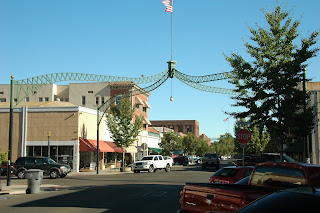During my drive from the North Bay to the Northwest, I took several breaks. And as I often do when traveling, I wandered around downtowns, camera in hand, looking at what’s working and what’s not. On this trip, my main photo stops were in Klamath Falls, Oregon and Marysville, California. The thoughts that jumped into my head are below.
 Observation
#13: Good bones aren’t nearly enough - No reasonable observer would describe
the downtowns of Klamath Fall or Marysville as healthy. In both places, I spied a few successful
businesses and a handful of pedestrians, but nothing like the level of activity
that can be found in most North Bay cities.
The downtowns of San Rafael, Santa Rosa, Sonoma, and other North Bay
cities have a vitality that far eclipses the street life in Klamath Falls and
Marysville.
Observation
#13: Good bones aren’t nearly enough - No reasonable observer would describe
the downtowns of Klamath Fall or Marysville as healthy. In both places, I spied a few successful
businesses and a handful of pedestrians, but nothing like the level of activity
that can be found in most North Bay cities.
The downtowns of San Rafael, Santa Rosa, Sonoma, and other North Bay
cities have a vitality that far eclipses the street life in Klamath Falls and
Marysville.
And yet both
Klamath Falls and Marysville have fine-looking downtown buildings. Rehabilitation would probably be needed required
to return some of the buildings to full utilization, but it’s always better to
begin with a downtown that has buildings, especially well-constructed
buildings, instead of empty lots.
It’s easy to
visualize a bustling downtown against a backdrop of the existing buildings in
either city. But neither city has that
bustle.
 It’s a
reminder that architecture isn’t enough.
Urbanism doesn’t spring from buildings alone, but from a complicated calculus
of downtown residents, businesses, jobs, other magnets, and well-managed
parking. The next time someone argues
that a building will revitalize downtown, look deeply into the proposal and
think about Klamath Falls and Marysville.
Buildings are essential but not sufficient for urbanism.
It’s a
reminder that architecture isn’t enough.
Urbanism doesn’t spring from buildings alone, but from a complicated calculus
of downtown residents, businesses, jobs, other magnets, and well-managed
parking. The next time someone argues
that a building will revitalize downtown, look deeply into the proposal and
think about Klamath Falls and Marysville.
Buildings are essential but not sufficient for urbanism.
Observation
#14: Helping hands are expensive and should be used well - Downtown Marysville
has arches at a number of intersections.
The arches are a good addition to downtown in both their aesthetics and
their reference to local history. They give Marysville a more interesting and
memorable downtown.
But there is
an apparent mismatch between the arches and the vacant buildings that stand
near It’s as if a
fondant frosting was applied to a wedding cake made of sawdust.
 This comment
isn’t intended as a criticism of the Marysville City Council which pursued the
funds for the arches. Nor is it an
argument that historical elements aren’t appropriate.
This comment
isn’t intended as a criticism of the Marysville City Council which pursued the
funds for the arches. Nor is it an
argument that historical elements aren’t appropriate.
Instead, it’s
a condemnation of a funding system that dictates the funding priorities of
cities. Whatever funds were devoted to
the arches could have been better spent in any number of areas, such as infrastructure
upgrades, historic building renovation tax credits, or rent subsidies for a new
wave of risk-oblivious downtown residents.
As a result, Marysville got arches and a comatose downtown.
Cities have
always been and will remain a primary economic driver in national and state economies. But the current model is to divert the
revenue to Sacramento or to Washington, D.C. and then to release it back to
cities with funding priorities set from above.
And so we get arches instead of people.
The arches
are a beautiful addition to downtown Marysville. But what would be truly striking would be
sidewalk cafes full of diners enjoying the evening breezes at the end of a
North Valley day. Whether or not the
arches are in the background.
And with
that, my Northwest observations are at an end.
The life conditions that allowed me to prosper during almost two decades
in the Northwest have passed, never to return, but I still enjoy visiting the
region. I’ll be looking for an
opportunity to return.
As always,
your questions or comments will be appreciated.
Please comment below or email me.
And thanks for reading. - Dave Alden (davealden53@comcast.net)


No comments:
Post a Comment